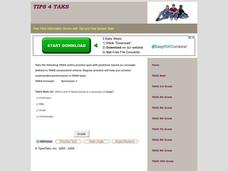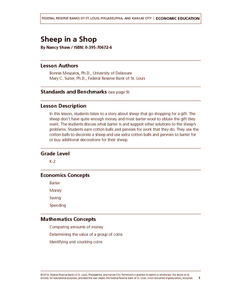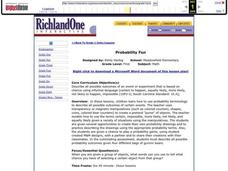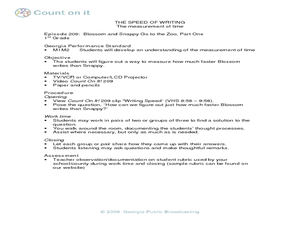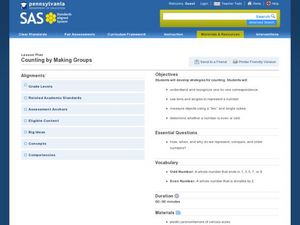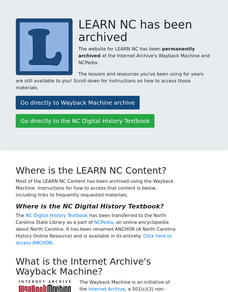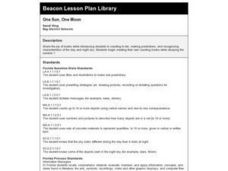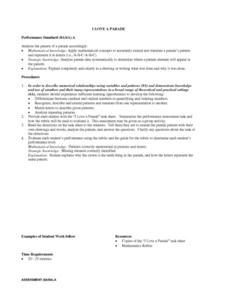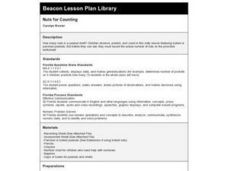Curated OER
Synonyms 1
In this on-line language arts learning exercise, students complete 1 multiple choice question where they choose the word that means the same as "large." Students can check their answers at the end of the learning exercise.
Federal Reserve Bank
Sheep in a Shop
What do you think sheep might be able to barter when they don't have quite enough to buy a gift? Your pupils can find out this and much more during this lesson about Sheep in a Shop, spending, saving, and bartering.
Curated OER
Learning about the World of Color, Object and Shape Patterns
First graders practice identifying and creating patterns by using unifix cubes. In this visual design lesson, 1st graders investigate reoccurring patterns using colors and shapes and extend what is being made with their unifix cubes....
Curated OER
Wonderful Watermelons
First graders explore watermelons and collect and sort their seeds. In this watermelons lesson plan, 1st graders read the story Down By The Bay and then weigh, measure, collect seeds, sort, and eat their watermelon.
Curated OER
Model Counting Pennies and Nickels
First graders provide monetary value of coins. In this counting pennies and nickels lesson, 1st graders practice counting money with a partner.
Curated OER
Patterns on Parade
First graders discover that patterns exist in sounds, movement, and objects. In this patterns lesson, 1st graders select two items from a group and produce an alternating pattern.
Curated OER
Measuring Fun
First graders practice measuring. In this measuring instructional activity, 1st graders read the story How Big Is a Foot? by Rolf Myller. They measure a partner using standard (ruler) and nonstandard (feet) units.
Curated OER
How Much is that Name?
Students explore money counting. In this money problem solving lesson, students calculate how much money their name is "worth" using the corresponding alphabet letters which have been assigned a coin value.
Curated OER
Our Town Store
Students purchase items in their classroom store. In this money instructional activity students create a classroom store. The students have a given amount of money and have to decide if they have enough to purchase the items that they...
Curated OER
Five Little Monkeys
Students listen to story Five Little Monkeys Jumping On The Bed, and act out subtraction situations.
Curated OER
Probability Fun
First graders use probability terminology to describe all possible outcomes of certain events. In this probability lesson, 1st graders use counters to create a pretend "purse" of objects. Students create their own probability drawings...
Curated OER
The Speed of Writing
First graders investigate how to measure time. In this time analysis lesson, 1st graders investigate ways to measure the time difference between two people writing. Students share their time measuring ideas with their classmates.
Curated OER
Tracking Olympic Gold!
Students use print or online resources to track the results of the Olympic Games, record daily results on graphs, use graphs to collect information.
Curated OER
Introducing Models to Elementary School Students
Students explore the concept of models. In this model lesson, students examine 3-dimensional models of various objects and body parts to better understand the natural world.
Curated OER
Counting by Making Groups
First graders represent, compare, and order numbers. In this counting skills lesson, 1st graders use manipulatives to demonstrate one-to-one correspondence and to represent numbers. This lesson includes a teacher script to guide the lesson.
Curated OER
Jumping Rules
First graders practice identifying number patterns. In this basic patterns lesson, 1st graders use a large number line and jump to certain numbers to create, identify or extend a pattern. This lesson includes a script to guide the teacher.
Curated OER
Congruent Boxes
Pupils decorate the congruent faces and edges of boxes in exactly the same way. They teach the terms "congruent," "faces," and "edges" to their parents.
Curated OER
One Sun, One Moon
First graders read "Ten Black Dots" by Donald Crews and then create their own counting books focusing on the number 1 (one) and using yellow dots to represent the sun, moon and stars.
Curated OER
Technology: Money Equivalency
First graders,working on computers, drag coins into boxes to equal amounts pictured. Following a demonstration, they demonstrate how to type number sentences. As an extension, 1st graders create equivalent amounts using specific numbers...
Curated OER
I Love a Parade
Students receive a worksheet that describes a parade. They tell what the 10th item in the parade will be. Students draw the parade, and tell the pattern they see using letters. Students design their own parade with the same pattern. They...
Curated OER
Marble Game
Students practice counting groups of items of six or more. They create equivalent sets.
Curated OER
Nuts for Counting
First graders observe, predict, and count in this nutty lesson featuring boiled or parched peanuts. They use a worksheet to record the actual number of nuts.
Curated OER
Sink or Float?
Students predict and explore to discover which objects sink or float in fresh and salt water, predict how salt affect objects, write predictions on T chart, discuss difference between man-made and natural waters, and graph results.


